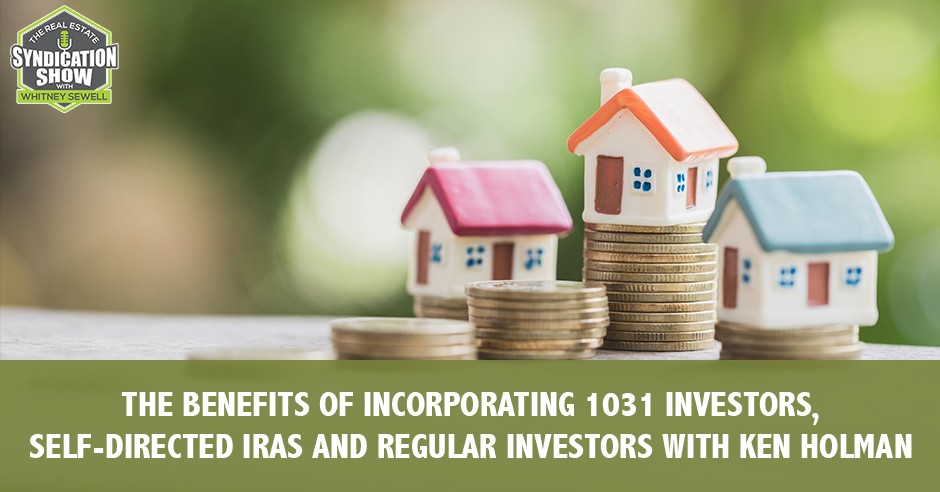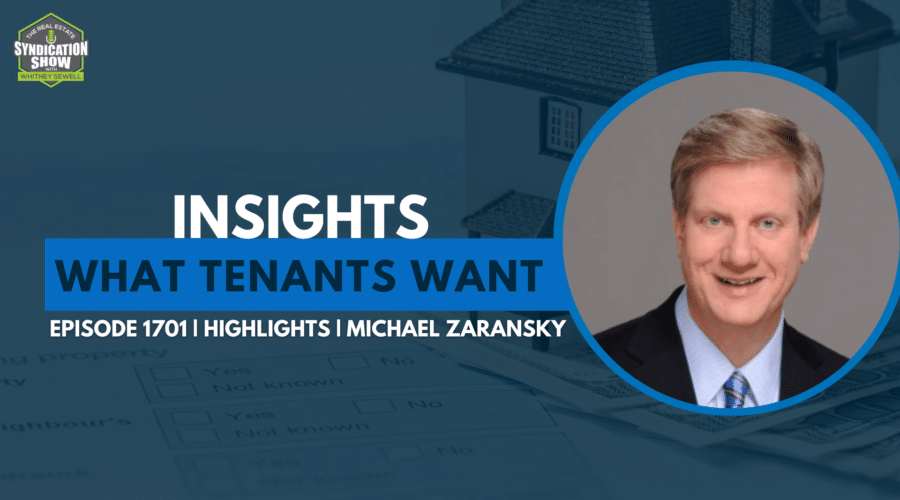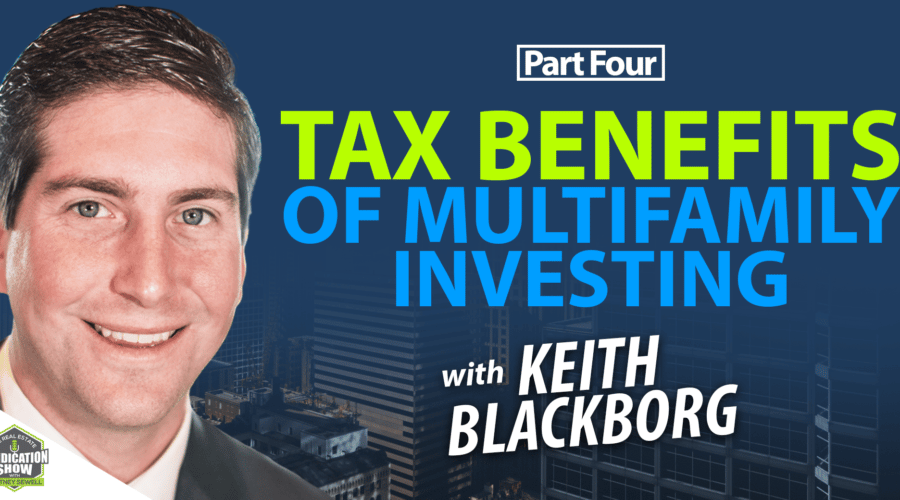
Listen to the podcast here:
Being in the world of real estate syndication requires not just simple knowledge but rather complex ones that require years of experience. Ken Holman, the President and CEO of Overland Group, talks about their fully integrated real estate company and how their family grew it into something massive in the real estate industry. He stresses the importance of choosing the right properties to deal with and the process of incorporating 1031, self-directed IRAs, and regular investors in the same project. Syndication may be difficult if you are starting out, that is why Ken shares some key things you have to do to be successful in the syndication business.
Our Gracious Sponsor:
Are you wanting to learn how to gain financial freedom through having your own syndication business? Text LEARN to 474747 to begin to learn from one of the best in the industry, Vinney Chopra. Vinney came to the US with only $7 in his pocket, and now controls hundreds of millions of dollars of real estate he has acquired through multifamily syndication. He is now personally coaching others to do the same. Text LEARN to 474747 to begin your journey to starting your own syndication business! Vinneychopra.com
—
Watch the episode here:
The Benefits Of Incorporating 1031 Investors, Self-Directed IRAs And Regular Investors with Ken Holman
Our guest is Ken Holman. Thanks for being on the show, Ken.
You’re welcome. I’m glad to be here.
With your experience and background, I’m honored to have you on and look forward to hearing about your experience. We’re going to learn a lot. Ken is the President and CEO of Overland Group, a privately held vertically-integrated real estate fund manager, investor and operator that builds, owns and finances properties across the United States. Since its founding, Overland Group has developed over twenty million square feet of commercial space and actively manages over 10.6 million square feet of office, industrial, retail, multifamily hotel and healthcare space. He holds the following designations: CCIM, CPM, CRS and CCA. He has also served as the President of the Utah Apartment Association. You’re about the most qualified guest I’ve ever had.
I’ve been around this business for a few years.
It’s great to know somebody like you who has had this much experience. Give the readers a little more about who you are and maybe a little bit about your background. Let’s dive right into our topic as well.
My background is maybe a little different than most real estate syndicators out there. I got all the standard degrees. Everybody else did a degree in Accounting and an MBA. I went into law school. I’m pretty qualified in that regard. The thing that prepared me for the real estate business was, while I was growing up in high school and college, I had an opportunity to work with my dad and my uncles doing real estate construction. I’ve done about everything you can imagine in the construction side of the business, from setting up forms and pouring concrete to doing a drywall and finish work and all different things like that. That’s probably the best side of the business that gave me an appreciation for real state. I was destined to be in this business from probably the beginning of my career.
In our company, Overland Group, we do all different aspects of real estate. It’s brokerage, development, construction, management and syndication. We try to tie all those things together into the projects that we develop. A couple of the projects that we’re working on that are interesting are two apartment developments. One is in Saint George, Utah, which is one of the hottest markets in the United States. Another project is in Mesa, Arizona. We’re also doing a self-storage project in Arizona. It opened up. We have a536-unit of self-storage projects in Woods Cross, Utah. I’m excited about that. I hope that goes well for us. We’re starting to rent units there.
You have such a wide range of things that you all are able to do. It’s so impressive. You’re managing over ten million square feet. You went through office, industrial, retail, multifamily hotel and healthcare. You’re doing all these different things. I would imagine you didn’t start that way.
We don’t manage ten million square feet now but we have over the years that we’ve been in business. We manage fewer than that, but we still are involved in all those product types. I manage most of the things we’re talking about.
What’s been the key in being able to grow your ability to be good in so many different asset classes?
[bctt tweet=”With new construction, you’re building primarily in markets that are moving up that are growing and developing.” username=””]
The main thing is I have been a student of the industry from day one when I got into it. I started working for a real estate syndication company. They did financial planning as well. I moved from there into my own company in the late ‘70s, early ‘80s. We’ve been going from there. It’s been a real progression. You don’t start out doing everything. I started out on the management side of the business and then was asked to manage several different projects in five different states. I went from there to start my own brokerage firm. We thought, “We’ll do development.” We started that and then a construction company. That was the one thing that almost took me down. It’s the construction side of the business. That’s been the most difficult to learn how to do and do it effectively. We started with a full-fledged construction company where we were not only doing the general contracting, but we also ran some of the sub-trades. We had close to 100 employees that we were dealing with. That was a nightmare.
One day, we had too much work to do. I was out hustling, trying to find new employees. The next day, we had finished a project and we were waiting to get another one going. I got to lay people off and that wasn’t very fun. We streamlined our model. That’s the thing that started helping us to get going the way we wanted to go. We got rid of all the sub-trades, didn’t try to self-perform anything and competitively bid all those things out. From a construction standpoint, we do project management, project engineering, estimating and superintending. Once we get to that superintendent level, we don’t self-perform everything below that. We competitively bid out. That enabled us to move into all different markets we otherwise wouldn’t be able to do. We’ve done projects in Utah, Colorado, Arizona, Wyoming, South Dakota and Montana, all over the inner mountain Midwest.
Are you all focused now mainly on new development?
We are. We like that space a lot. It’s not that you can’t do what we do by acquiring existing projects, but I found I like to build new as opposed to buying somebody else’s problems. By building new, you can overcome a couple of things. If you’re acquiring existing properties, you run across economic and functional obsolescence that you have to deal with. Economic obsolescence means you’re in a market that either is moving up, down or sideways. With new construction, you’re building primarily in markets that are moving up that are growing and developing. There are a lot of upsides to that. In functional obsolescence, you run across situations like an apartment complex that has an eight-foot-high ceiling. Now, everything is nine feet. It’s hard to overcome those things. Some of the energy savings that exist now didn’t exist back then. A new development is a good path for us.
The other thing I like about new development is you’re building at cost. Once you get that project run ADAP, you wind up having a significant value-add situation that can add 10% to 20% of the value of the project to its overall value. Once you go through that process of development, construction, ran up and stabilization, people are willing to pay more money for a stabilized project than one that is not stabilized. You build it at one price and value-added another. It’s good for investors to be able to have that increase in value that exists. You do have to go through the risk of going through that whole process. After you’ve been through it as many times and as many years as we have, we feel like we’ve got a handle on how to manage the risk. We feel pretty good about that.

It’s many years of experience. You mentioned that what prepared you was the time spent with your father and uncles, building and construction and doing all those things in real estate. If you had to do it over, would you still get the law degree and the other things as well?
You have to. I don’t think you can do this business without having the proper education, background and being able to understand all the legal ramifications associated with this business. This is a technical business. There are not very many places you can go to get an education for that. After I got my Accounting degree and an MBA, which I felt qualified me pretty well, I said, “There’s so much on the legal side of this business that I don’t know. I want to learn that.” There isn’t anywhere that teaches that. I applied to law school. While I was running my company, I decided, “I’m going to go to law school. I’m going to get those classes that relate to real estate,” because they don’t let you take those classes without being enrolled as a student. I went in and took all the real estate classes I could find about real property law, contracts, mortgages, tax and all that. Once I got all that stuff I said, “I don’t want to be an attorney. I’ve got what I need.” That helped prepare me a lot for this business.
It’s impressive that you’re able to do that while you were still running your real estate business.
Most of the employees that were working for me thought I was nuts. It’s something that I thought we needed to do to make this a successful company the way we wanted to.
You and I were discussing how you’re incorporating 1031, self-directed IRAs and regular investors in the same projects. We thought that would be a great topic and item for us to dive into a little bit in how you’re able to do that. I’d love for you to talk about that.
[bctt tweet=”You cannot do business without having proper background and education to understand all legal ramifications associated with the business.” username=””]
Most syndicators these days go out and find a group of investors that have some equity capital that they want to invest in a project. That’s the approach that they take. We get a lot of those investors. At this stage of my career, I like to work with bigger investors as opposed to smaller investors. I have found that it’s possible to incorporate 1031 tax-deferred exchange investors with self-directed retirement account investors and regular investors. That’s not an easy process to do. It might be fun for your readers to read an explanation of how we go about that process. Maybe there are others who would want to incorporate that into their business model. Most real estate projects are done through the formation of a limited liability company, which is the crux of the legal organization that you set up to run the project.
Most of these are single-asset entities. We form an LLC. An LLC is a security. You get into all of the SEC requirements relative to registration, non-registration or being exempt from registration. We all deal with Reg D. One of the rules is either 506(b) or 506(c). 506(c) is the one that most people gravitate to because it doesn’t restrict your ability to advertise. You have to deal with accredited investors. You cannot only include in that LLC regular real estate investors. Most people don’t realize that you can take an IRA or a 401(k). If you have turned it into a self-directed IRA or 401(k), and there are several companies out there that can assist investors to do that, you can then take that IRA, 401(k) or any other type of basic retirement account and invest directly in real estate. Most stockbrokers and financial planners don’t tell you about this because they don’t want to deal with you taking some of your assets or capital and moving at the end and investing directly in real estate. We work with a lot of clients in accommodating that. I had one client out of Tucson, Arizona. He’d been with me for a long time. He called me one day and said, “I heard you’re building a Family Dollar store in Colorado. I’m sick of being in the stock market. I’ve got $2 million in my 401(k). Help me figure out how to get that money into your real estate deals.”
Somebody says that you’re jumping. You’re ready to help.
We did that. He’s now invested in three projects with me. He got about $1.5 million invested in various things that we’re doing. We’ve been able to assist a lot of clients in how to do self-directed IRAs and 401(k)s. I have my favorite companies. I won’t advertise them here but if somebody wants to call, they’re welcome to do that. The interesting side of all these is the 1031 tax-deferred exchange investor. They cannot invest in the LLC because it has to be a like-kind exchange. It’s real estate for real estate. You can’t exchange a real estate project for any interest in an LLC. We find that we can take the land and have LLCs acquire the land because it’s real estate. They acquire the land and we form what’s called a Tenant in Common Agreement, a TIC. That word has been used for good and bad. Some of the TICs in past years have not been good with investors. It’s generally because the sponsor that’s doing the TIC has no vested interest in the project. In our situation, we put our own capital in. We sign on the note. We guarantee the loan. We have a vested interest to see that the project is done. We then can take those 1031 investors and marry that with the LLC. Those two become co-owners of the project. The Tenant in Common Agreement is what controls as opposed to an LLC. By doing that, we’ve been able to get all those interests together in the same project and have it be successful.
A 1031 investor can’t invest in regular syndication because they’re buying a share of an entity. They’re not buying real estate. Is that correct?

That’s right. They can’t buy an interest in an LLC because it’s not considered a like-kind exchange. The government requires for a 1031 exchange to be like-kind, meaning real estate for real estate. It doesn’t have to be an apartment for an apartment or an office building for an office building. It can be any type of real estate for any other type of real estate. You can do a like-kind exchange. The exchange has to be for an equal or greater value than the asset that you’re replacing.
Instead of doing the LLC, you’re going to do a Tenant in Common. That’s a way around to somebody with a 1031.
That’s the way you marry the two. The Tenant in Common becomes the controlling entity and the LLC and the 1031 investors are co-owners of that. That’s a way that you can incorporate all that money, all that investment capital, into the same project and get it to work. A couple of little nuances for 1031 investors that they have to be aware of when you’re doing a deal like that is those guys particularly have a different ownership interest in the asset that they’re buying than they do in the project that you’re building. For instance, you may buy a piece of land for $1 million or $2 million. If somebody’s putting in $200,000 in a $2 million project, they’ll own 10% of the land. Maybe the project that you’re building is a $20 million project. There is a $200,000 investment and they have 10% ownership in the project. You have to make sure that all the documentation that you do states that they have a certain of percentage ownership in the land. That translates into a different ownership interest when they’re a part of a larger project. I couldn’t stress enough how important it is to get good legal advice on how to do all of this. You don’t want to go out and do this without getting good representation and making sure that you have people and understand not only the security side of the business but the real estate side of the business.
You could be investing your $200,000 and only get a portion of the land itself. This building’s built. Maybe it’s sold later on down the road. You’re only getting a portion of the value of the land.
You may own 10% of the value of the land, but say you’re building a $20 million project and you’ve got 25% of that that you’re raising as equity capital. You’ve got a $5 million raise. That $200,000 ownership interest represents $200,000 of a $5 million transaction. They have a lot of smaller ownership interest in the actual project. We try to make sure that everybody is treated equally. The 1031 investors’ requirements mirror what we’ve done with the LLC in terms of the operating agreement. That may be a complicated transaction. Some of your newer guys may not be ready to do a deal like that. When you’re talking about raising $5 million to $10 million on a transaction to do a project anywhere from $20 million to $40 million somewhere in that range, it makes it possible to incorporate all of those different types of entities and investors and raise a lot more equity capital than you could otherwise if you’re dealing with one investor type.
[bctt tweet=”Not every deal is going to work out the way that you plan it to work out.” username=””]
You’ve been in this business and you’ve educated yourself, which is amazing. Somebody who’s just getting it now comes to you and says, “I want to get started in this syndication business.” What are some of the first key things that they have to do to be successful?
Start small. You’re not going to go out and tackle two bigger projects. Your first investments are with family and friends or those business acquaintances that you know. I would probably start with a triple net lease type project. You could do something like a Family Dollar, Dollar Tree or Dollar General. All of those are a triple net lease. You can do some other type of small investment. I’ve seen some groups do these with fourplexes. We don’t do many single-family homes in this format because it is so complicated and expensive to do. It’s unwarranted with a single-family home. With a small real estate deal of $1 million or $2 million, you could do this.
I would advise people to, first of all, make sure that the project you’re doing is not only suitable for the type of investment that you’re seeking. These things have a situation where they’re small enough but perform well-enough. You can give the type of return that you want to give to the investors. You’re not going to attract any investment capital unless you can give a return that is suitable. This may seem a little bit high but on new development, you can do this. We try to hit a threshold of 20% IRR. A lot of times, they’re more within a 12% to 15% range. Our deals are a little bit more aggressive in that regard. You’ve got to get in that 15% range. You’ve got to provide some preferential return to these investors to attract them and be able to compete with the others. If you can do that, you can be a small syndicator, get started, get going and they still didn’t do well.
What’s a way that you have improved your business that we can all apply to ours?
The social media side of the business is an area that I’ve grappled with and we worked on over the years. Having a conversation with you is a way for me to get my message out to potential investors. One of the best sources that have helped me is developing a good database of LinkedIn connections. For instance, I went to the State Securities Division one day, which is like going to the IRS and saying, “Would you look at my tax return and see if I filled out the forms correctly and if I’m paying enough in taxes?” I went to the State Securities Division and said, “I understand that for me to do these projects, I have to have a pre-existing business relationship with these people who I’m doing business with. How do I do that? What qualifies as a preexisting business relationship?”

They started out by saying, “Family and friends qualify to do that.” I said, “What other documentation do I need?” They said, “If you have business relationships.” I said, “How do you verify that?” They said, “If you’ve got a business card, you talk to them and they talk to you.” I thought, “I’ll work on that angle.” About my LinkedIn, I had at the time about 250 first-tier connections. It wasn’t very big. I said, “Would those guys qualify?” They said, “Yeah. If you’ve got a first-tier connection with some individuals that say they’ve reached out to you, you’ve reached out to them and you’ve established a relationship.” I said, “How about my second and third-tier? I’ve got over 1,000 of those guys.” He says, “We don’t think those guys qualify because you haven’t reached out to them. They’re just people that you could reach out to.” I went back to my office and said, “If first-tier connections qualify as pre-existing business relationships, I better get with it.”
I capped out at 30,000. Now I’m trying to figure out how to grow beyond 30,000. LinkedIn stops you at 30,000. They have been a terrific avenue for me to raise equity capital and develop relationships. I send out a monthly newsletter. I call the Overland Advisor to any of those contacts that I’ve got. It’s been a good format for me to grow my business. The social media side of the business is where you need to go if you’re going to reach out to investors. You can find a good project if you work hard enough. The hardest side of that ledger is developing the relationships with the investors and getting yourself known so people feel comfortable working with you and trust putting their equity capital with you. It’s a big responsibility to be responsible for that capital. Often, they take years and years to accumulate. You don’t want to destroy that relationship or lose their money.
What’s the number one thing that’s contributed to your success? It’s what you would consider being the top quality or top thing that’s done it for you.
The top thing is doing the best I possibly can to make sure I give these investors a fair deal. That seems basic, but not every deal is going to work out the way that you plan it to work out. You’ve got to be able to have the intestinal fortitude that when a deal isn’t working exactly as you expected, you’re willing to reach out to those investors, be honest with them and tell them what’s going on and the solution that you have for the problem that exists. We had a situation where we did a feasibility study. We had a great company prepare this study. There are all sorts of positive responses. We knew it was the right market to be in. We build in that market. Within a year, we had four competitors sitting right on top of us. The ran up is not going to go as fast with four competitors as it was going to go where you were the only guy in the market. You have to reach out to those investors and say, “Here’s where we are now. Here’s our model. Long-term, we know we’re in the right market. It’s growing the way we want it to grow. As the project gets stabilized, we’re going to hit all our numbers. You have to be patient with us getting there.” If they know that, they’re willing to work with you.
Tell the readers how you like to give back.
[bctt tweet=”You’re not going to attract any investment capital unless you can give a return that is suitable.” username=””]
I’m guessing that most of your readers are familiar with Rotary International. I was one of the founding members of our local chapter. Over the years, that has been an amazing way to give back. Over several years ago, they decided that they would eradicate polio from the face of the earth. It was a big undertaking. Over those years, they’ve teamed up with the Gates Foundation and other entities. With all of us contributing donations to that cause, they’ve eliminated it in every country but three, which is pretty amazing. Being part of a local group, you get to do all kinds of charitable things with activities that you do and scholarships that you provide. I’m a Paul Harris Fellow, which sounds like a big deal but there are a million of us in Rotary that are that. We’ve all donated money to become Paul Harris Fellows. That money all gets used to doing all kinds of third-world projects like building schools. Our local group has built schools and done water projects in third-world countries. We’ve been able to do a lot with a little. That’s probably one of the bigger ways I’ve found that has been gratifying to give back.
Thank you for sharing that. I appreciate your time and you sharing your expertise. Tell the readers how they can learn more about you and get in touch with you.
We’re the Overland Group. You can find us on our website at OverlandGroupInc.com. You’re welcome to give me a call. Our phone number is (801) 355-1111. You’re welcome to reach out to me personally at [email protected].
Can we reach out on LinkedIn?
If you contact me through LinkedIn, I can put you in our real estate investment group. We’re growing that. We’ve got several hundred members in that. That’s a LinkedIn group that you can join to be a part of what we do. It’s called Commercial Real Estate Investment Group and Network.
About the Overland advisor, do we sign up for that on your website?
You could contact us. I don’t know that we have the Overland advisor that you can sign up on our website but contact me. Send me an email. I’ll make sure that you’re added to our Overland advisor newsletter group. That’s all about investing.
Ken, you’ve been a great guest. I can’t thank you enough for your time. I hope we’ll have you back on the show in the future as well. There are so many topics that we could talk about and cover. Thank you so much. I appreciate the readers being with us now and every day. I hope you all will come back soon. I hope you’re growing your business and learning a lot from the show and sharing it with your friends. Please go to Life Bridge Capital and connect with me. I’m happy to schedule a call and help you any way I can. We will talk to each of you soon.
Important Links:
- Overland Group
- Utah Apartment Association
- Rotary International
- Gates Foundation
- OverlandGroupInc.com
- [email protected]
- Ken Holman on LinkedIn
About Kenneth T. Holman
 Kenneth T. Holman has had a long and distinguished career in real estate. He obtained his real estate license in 1972 and his real estate broker’s license in 1975. Over the years he has brokered, developed, constructed, and owned over $500 million in real estate assets which have included apartments, condominiums, industrial properties, self-storage projects, office buildings, hotels, a golf course, retail properties, fast-food restaurants and other types of commercial properties.
Kenneth T. Holman has had a long and distinguished career in real estate. He obtained his real estate license in 1972 and his real estate broker’s license in 1975. Over the years he has brokered, developed, constructed, and owned over $500 million in real estate assets which have included apartments, condominiums, industrial properties, self-storage projects, office buildings, hotels, a golf course, retail properties, fast-food restaurants and other types of commercial properties.
Presently, Mr. Holman is the manager of numerous limited liability companies and an investment partner with several investors in numerous real estate ventures.
Love the show? Subscribe, rate, review, and share!
Join the Real Estate Syndication Show Community:



